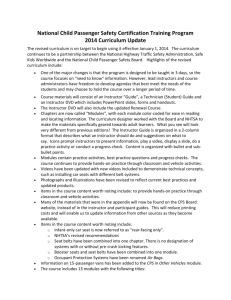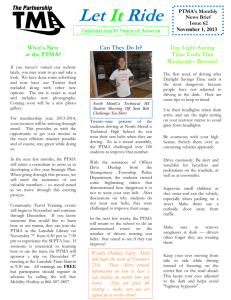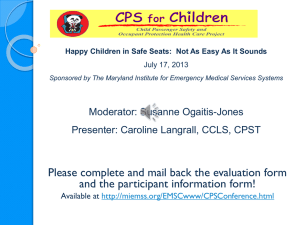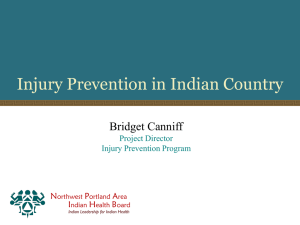car seat recommendations - USEP-OHIO
advertisement
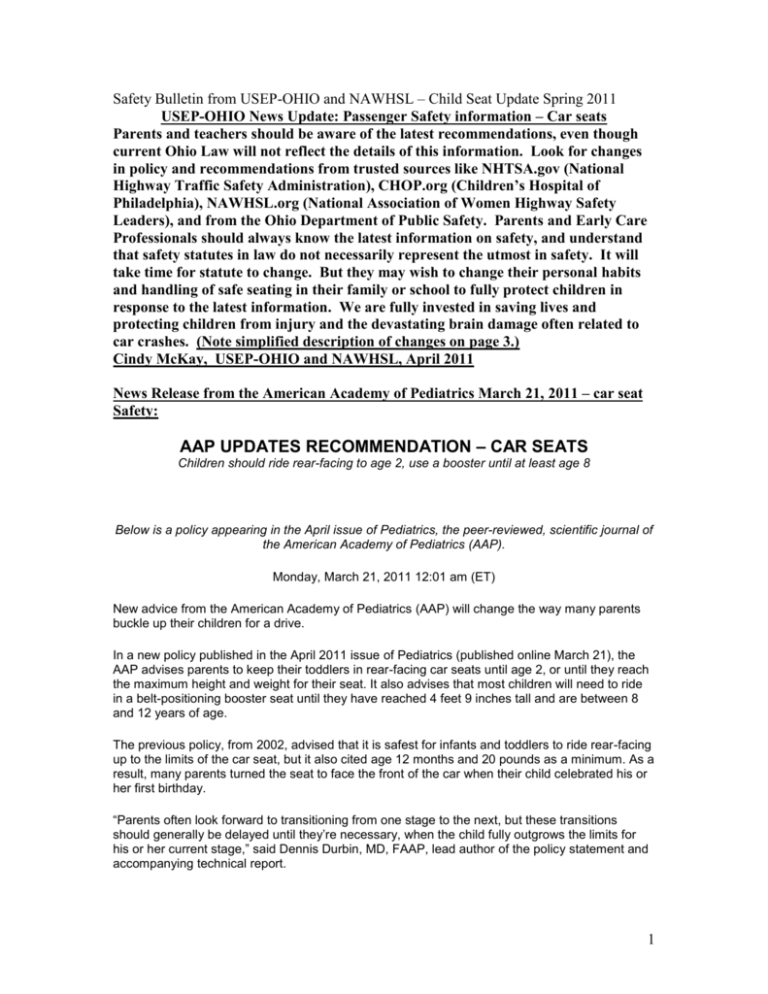
Safety Bulletin from USEP-OHIO and NAWHSL – Child Seat Update Spring 2011 USEP-OHIO News Update: Passenger Safety information – Car seats Parents and teachers should be aware of the latest recommendations, even though current Ohio Law will not reflect the details of this information. Look for changes in policy and recommendations from trusted sources like NHTSA.gov (National Highway Traffic Safety Administration), CHOP.org (Children’s Hospital of Philadelphia), NAWHSL.org (National Association of Women Highway Safety Leaders), and from the Ohio Department of Public Safety. Parents and Early Care Professionals should always know the latest information on safety, and understand that safety statutes in law do not necessarily represent the utmost in safety. It will take time for statute to change. But they may wish to change their personal habits and handling of safe seating in their family or school to fully protect children in response to the latest information. We are fully invested in saving lives and protecting children from injury and the devastating brain damage often related to car crashes. (Note simplified description of changes on page 3.) Cindy McKay, USEP-OHIO and NAWHSL, April 2011 News Release from the American Academy of Pediatrics March 21, 2011 – car seat Safety: AAP UPDATES RECOMMENDATION – CAR SEATS Children should ride rear-facing to age 2, use a booster until at least age 8 Below is a policy appearing in the April issue of Pediatrics, the peer-reviewed, scientific journal of the American Academy of Pediatrics (AAP). Monday, March 21, 2011 12:01 am (ET) New advice from the American Academy of Pediatrics (AAP) will change the way many parents buckle up their children for a drive. In a new policy published in the April 2011 issue of Pediatrics (published online March 21), the AAP advises parents to keep their toddlers in rear-facing car seats until age 2, or until they reach the maximum height and weight for their seat. It also advises that most children will need to ride in a belt-positioning booster seat until they have reached 4 feet 9 inches tall and are between 8 and 12 years of age. The previous policy, from 2002, advised that it is safest for infants and toddlers to ride rear-facing up to the limits of the car seat, but it also cited age 12 months and 20 pounds as a minimum. As a result, many parents turned the seat to face the front of the car when their child celebrated his or her first birthday. “Parents often look forward to transitioning from one stage to the next, but these transitions should generally be delayed until they’re necessary, when the child fully outgrows the limits for his or her current stage,” said Dennis Durbin, MD, FAAP, lead author of the policy statement and accompanying technical report. 1 “A rear-facing child safety seat does a better job of supporting the head, neck and spine of infants and toddlers in a crash, because it distributes the force of the collision over the entire body,” Dr. Durbin said. “For larger children, a forward-facing seat with a harness is safer than a booster, and a belt-positioning booster seat provides better protection than a seat belt alone until the seat belt fits correctly.” While the rate of deaths in motor vehicle crashes in children under age 16 has decreased substantially – dropping 45 percent between 1997 and 2009 – it is still the leading cause of death for children ages 4 and older. Counting children and teens up to age 21, there are more than 5,000 deaths each year. Fatalities are just the tip of the iceberg; for every fatality, roughly 18 children are hospitalized and more than 400 are injured seriously enough to require medical treatment. New research has found children are safer in rear-facing car seats. A 2007 study in the journal Injury Prevention showed that children under age 2 are 75 percent less likely to die or be severely injured in a crash if they are riding rear-facing. “The ‘age 2’ recommendation is not a deadline, but rather a guideline to help parents decide when to make the transition,” Dr. Durbin said. “Smaller children will benefit from remaining rearfacing longer, while other children may reach the maximum height or weight before 2 years of age.” Children should transition from a rear-facing seat to a forward-facing seat with a harness, until they reach the maximum weight or height for that seat. Then a booster will make sure the vehicle’s lap-and-shoulder belt fit properly. The shoulder belt should lie across the middle of the chest and shoulder, not near the neck or face. The lap belt should fit low and snug on the hips and upper thighs, not across the belly. Most children will need a booster seat until they have reached 4 feet 9 inches tall and are between 8 and 12 years old. Children should ride in the rear of a vehicle until they are 13 years old. Although the Federal Aviation Administration permits children under age 2 to ride on an adult’s lap on an airplane, they are best protected by riding in an age- and size-appropriate restraint. “Children should ride properly restrained on every trip in every type of transportation, on the road or in the air,” Dr. Durbin said. See more information on Car Seats Policy and Car Seat Technical Report details at the following link: www.healthychildren.org Car Seats Policy Car Seat Technical Report A car seat guide for parents is available at www.healthychildren.org/carseatguide The American academy of Pediatrics is an organization of 60,000 primary care pediatricians, pediatric medical subspecialists and pediatric surgical specialists dedicated to the health, safety and well being of infants, children, adolescents and young adults. The following is a simplified article listing the AAP recommendations by age. The AAP guidelines are listed on their website, along with tips and recommendations for installing safetyapproved car seats. These updated guidelines are very important for the safety your child or children. 2 : The (AAP) American Academy of Pediatrics has updated the guidelines for child car seat safety and all parents, grandparents and caregivers with responsibility for transporting children must heed these recommendations. Car seat safety is critical for safety and comfort of your children. The following guidelines are issued by the AAP: Infants Infant seats or rear-facing convertible seats are required for children under 2 years of age and until they reach the highest weight or height allowed by the car seat’s manufacturer. Although it may be tempting to turn a child forward-facing prior to his or her 2nd birthday, it is not safe for children to ride facing forward at this age. Even when their legs seem to push against the seat, it is safer for their head, shoulders, and neck to be supported in the rear-facing position. Toddlers Toddlers and preschoolers should use convertible seats and forward-facing seats with harnesses. They should continue using these safety seats as long as possible with the highest weight or height allowed by the car seat’s manufacturer. Height and weight guidelines are clearly listed on all approved car safety seats so check them periodically against your child’s size. School-aged Children Children are anxious to be “grown up” and to move out of a car seat, but even school-aged children must use proper booster seats. A belt-positioning booster seat is required until a child reaches 4 feet 9 inches in height, which is usually between 8 - 12 years of age. Make sure the seat belt lies comfortably over the shoulder and across the child’s chest. Older Children Don't be tempted to allow children to ride in the front seat before they are old enough and big enough. Children should be at least 13 years of age before they are allowed to ride in the front passenger seat. They must also be able to wear the vehicle seat belt alone. -END- This message is brought to you by USEP-OHIO (United Services for Effective ParentingOhio, Inc.) and NAWHSL (National Association of Women Highway Safety Leaders, Inc.) www.usep-ohio.com and www.nawhsl.org 3





